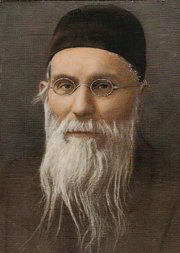Nosson Zvi Finkel
|
|
Nosson Zvi (Nota Hirsh) Finkel (1849-1927), was born in Lithuania and died in the British Mandate of Palestine. He was an influential leader of Orthodox Judaism in Eastern Europe. He is better known by his Yiddish name as the Alter ("elder") and founder of the Slabodka Yeshiva, in the town of Slabodka (a suburb of Kaunas). Many of his pupils were to become major leaders of Orthodox Judaism in the USA and Israel.
| Contents |
Early years
Nota Hirsch was orphaned at an early age, and not much is known about his formative years. What is known is that he was an early disciple of the nascent Mussar movement, founded and led by Rabbi Yisrael Lipkin Salanter.
Philosophical approach
Despite his influence, he was an intensely private person. Yet, he personally oversaw the complete student body of the yeshiva.
His motto was summed up in the words Gadlut Haadam ("Greatness of Man"). He stressed the need for mussar (ethics), using works such as those of Rabbi Moshe Chaim Luzzatto, polishing the character traits of his students so that they would aspire to become gedolim - "great ones" in all areas of both scholarship, and personal ethics .
He spent ten out of every twelve months with his students full time, only returning to his wife for the Jewish holidays. He had special agents that would keep an eye out all over Europe for teenagers with an aptitude for both scholarship and leadership, recruiting them and bringing them back to Slobodka. He attained unusual success, and his students subsequently reflected that he was a master of the human psyche and knew just which psychological buttons to press to give direction to his students' lives.
He would monitor the extra-curricular behavior of students judging their character faults and strengths. He was responsible for deciding which boys would share rooms together, weighing the strengths of one against the other. Some were chosen to be his personal assistants. He stressed the importance of outer appearance and the need for neatness and cleanliness. He did not want the image of the poor, tattered, down-trodden yeshiva bochur (yeshiva student) to be associated with the alumni of his institution. The rabbinical and Talmudical graduates of the Slobodka Yeshiva tried to live up to a higher code of dress and deportment, to the point of being accused of being dandies.
He would send teams of his trained prized pupils to places that needed a boost in religious observance and learning of Torah. His own son, Eliezer Yehudah (Lazer Yudel) Finkel eventually became the head of the far older Mir yeshiva, eventually leading it all the way to Jerusalem where it is today the largest post-high school yeshiva in the world with thousands of students.
Opposition
His main opponents in the "yeshiva world" were the members and alumni of the Brisk yeshiva of Lithuania headed by the Soloveitchik family, who, unlike their kin Joseph Soloveitchik who eventually moved to the United Sates, were adamantly opposed to any changes in what they believed to be the time-tested ways of yeshiva education. To this day, their yeshivot, based mainly in Jerusalem today, do not teach mussar ethics as some sort of special curriculum, but focus on pure Talmud study.
Rabbi Finkel's opponents argued that the pure focus on the Talmud would automatically create greatness in both scholarship and ethics. But Rabbi Finkel believed that, while this might have been true in previous generations, the modern age was different. In his view, too many new enticing secular ideologies, such as Socialism and Zionism and the very real lure of atheism in universities, were becoming a replacement for traditional Judaism for many young Jews. He was determined to prove that what he had to offer was just as appealing as anything the outside world could offer.
Land of Israel
Rabbi Nosson Tzvi Finkel staged one of the most dramatic moves in the history of yeshivot. In the 1920s he decided to create a branch of his yeshiva in the British Mandate of Palestine, together with the dean Rabbi Moshe Mordechai Epstein, setting it up in Hebron and sending waves of hand-picked students there, culminating with his own permanent aliyah, "going up", to the Holy Land two years before his passing.
In Palestine he founded his own institution in the town of Hebron called Knesses Yisroel - "Gathering of Israel", which moved to Jerusalem following the massacre of Jews during the 1929 Hebron massacre in which some of the yeshiva students perished.
Influence
During his lifetime, he moulded many who would eventually become the heads (Roshei Yeshiva) of most of the so-called Lithuanian-style Yeshivot that were established in the United States and Israel during the 20th century, and which continue to grow dramatically in the 21st century. Some of the more famous ones are:
- Eliezer Yehuda Finkel (son of the Alter) of Mir yeshiva in Jerusalem, Israel
- Yitzchok Hutner of Yeshivas Chaim Berlin of Brooklyn, New York
- Yaakov Kamenetzky of Torah Vodaath inBrooklyn, New York
- Aaron Kotler, of Beth Midrash Gevoha in Lakewood, New Jersey
- Dovid Leibowitz of Rabbinical Seminary of America in Queens
- Yaakov Yitzchok Ruderman of Ner Israel in Baltimore, Maryland
- Yechezkel Sarna, head of Chevron Yeshiva, Jerusalem, Israel
- Isaac Sherr, head of the Slabodka yeshiva of Bnei Brak, Israel
- Elazar Shach of Ponevezh yeshiva in Bnei Brak, Israel
The Alter did not personally author any books or essays, but some of his ethical discourses were published under the name Ohr HaTzafun - "The Hidden Light", (also meaning "The Light of the Hidden (One)"). The word Ha-Tz[a]-F[u]-N also being the four initials of his name, but not in order ("Hirsh-Tzvi-Finkel-Nota"). The title alludes to the hidden and mysterious nature of its subject, as he used to sign his name as Hatzafun.
External links
- Spending time in Slobodka (http://www.tzemachdovid.org/Musar/slobodka.html)
- Learning from the Alter (http://www.torah.org/learning/mussar-psych/mussar1.html)
- 1929 Hebron massacre Slabodka victims (http://www.hebron.org.il/pics/tarpat/martyrs.htm)

